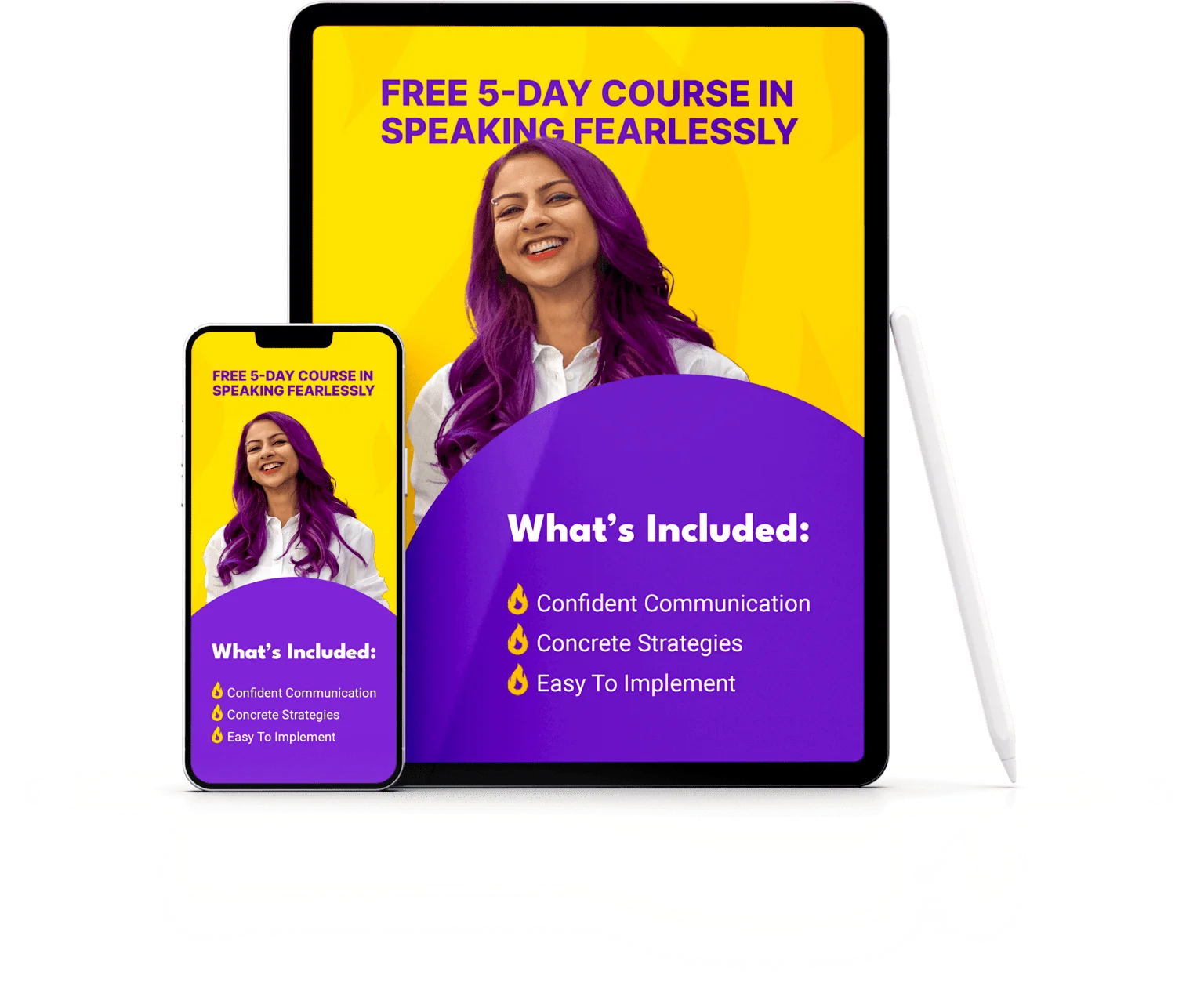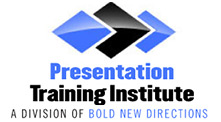The Power of Nonverbal Communication in Public Speaking
- Speaking tips , Presentations , Psychology
Public speaking is more than just the words you say. It’s about how you say them, how you connect with your audience, and the messages you convey through your nonverbal communication.
In this comprehensive guide, we will explore the significance of nonverbal communication , the key elements that make up nonverbal cues, and practical strategies to harness this power to become a more effective and persuasive public speaker .

Table of Contents

The Silent Language
Nonverbal communication, often referred to as “the silent language,” encompasses all the ways we convey information without using words. It’s a potent form of communication because it operates on a subconscious level, influencing how our message is received and interpreted by our audience.
This encompasses a wide range of cues, including:
- Body Language : Your posture, gestures and physical movements.
- Eye Contact : The way you make and maintain eye contact with your audience.
- Proximity : How close or far you are from your audience or other individuals on the stage.
- Appearance : Your clothing, grooming, and overall appearance, which can influence your audience’s perception.
- Use of Space : How you move around the stage or speaking area, including gestures and body positioning. This even includes how you use the frame on camera if you’re speaking online.
- Silence : The pauses and moments of silence in your speech, which can convey meaning and emphasis.
- Facial Expressions: We often have a poker face which does’t do much to enhance the message we’re aiming to convey. Facial expressions that go with the message can amplify your impact.

Photo by Natasha Hall on Unsplash
The Impact of Nonverbal Communication
Nonverbal communication plays a critical role in public speaking for several reasons:
1. Conveys Emotion and Authenticity
Your facial expressions, gestures, and tone of voice allow you to express emotions authentically. When your nonverbal cues align with your message, it adds depth and authenticity to your talk. For example, a smile can convey warmth and approachability, while a furrowed brow may signal concern or seriousness.
2. Enhances Message Clarity
Nonverbal cues can clarify your message, making it easier for your audience to understand and remember. Hand gestures can illustrate key points, and vocal variations can emphasize critical information. These cues act as signposts that guide your audience through your speech.
Pro-tip: if you over-do hand gestures or use repetitive ones, they can be distracting and damage your impact instead of enhancing it.
3. Builds Connection
Effective nonverbal communication helps you establish a strong connection with your audience. Maintaining eye contact, for instance, fosters a sense of engagement and rapport. A speaker who appears confident and approachable through their body language is more likely to connect with the audience .

4. Captures Attention
Engaging nonverbal cues can capture and maintain your audience’s attention. Movement, gestures, and vocal changes can add dynamism to your speech, preventing your audience from becoming disengaged or bored.
In a world where we’re constantly bombarded with notifications and urgent tasks, gaining attention is the real currency.
5. Demonstrates Confidence
Confidence is a quality that every public speaker should exude. Nonverbal cues such as upright posture, steady eye contact, and controlled body movements convey confidence to your audience. When you appear confident, your audience is more likely to trust and respect your message.
Key Elements of Effective Nonverbal Communication
To harness the power of nonverbal communication in public speaking, it’s essential to focus on specific elements and techniques. Let’s explore these key elements:
1. Body Language
Our posture, movements, and gestures are like an open book, revealing our emotions, confidence level, and authenticity. Here’s how body language can enhance or hinder your public speaking:
Posture : Stand or sit upright with your shoulders back. Good posture exudes confidence and presence. Conversely, slouching or crossing your arms can signal insecurity or defensiveness.
Gestures : Use purposeful hand gestures to emphasize points or convey information. Avoid excessive or distracting movements.
Movement : Move purposefully and with intent. Don’t pace nervously, but rather use movement to engage different sections of the audience or transition between points. Moving purposefully and making eye contact with your audience conveys that you’re fully engaged and interested in their response.
Note for speaking online : people often ignore movement and body language when speaking on camera. But in this context, it’s even more important to be more active and confident as the audience receives less information about your presence.
Enhance your on-camera body language by being aware of the frame, using gestures that are within the frame and being intentional with the frequency and variance of your gestures.
Credibility : Avoiding distracting movements, such as fidgeting, pacing excessively or swinging in your chair. This enhances your credibility as a speaker and shows that you’re grounded (literally!).

2. Eye Contact
Maintain Connection : Make eye contact with individuals throughout your audience to create a sense of connection and engagement. This is possible to do online as well – look into the camera instead of looking at yourself or your presentation .
Avoid Staring : Don’t fixate on one person or object for too long, as it can make your audience uncomfortable. Instead, distribute your gaze evenly.
Use of Notes : If using notes or slides, ensure you don’t rely on them excessively. Maintain eye contact while referencing your materials. Pro-tip: Don’t have full sentences on either your slides or your scripts. Have keywords instead and string together the sentences on the spot- this enhances improvisation and makes you sound fresh and natural.

3. Proximity
Your proximity to the audience and your use of personal space can create a sense of intimacy or formality:
Close Proximity: Stepping closer to the audience during a compelling point can create a feeling of closeness and connection.
This works in the online context as well – you’ll notice how the audience reacts when you lean in or when you sit back.
4. Appearance
Dress Appropriately : Your attire should align with the formality and expectations of your audience and the occasion. Dressing well can enhance your credibility.
When in doubt, go a bit more formal vs casual as a rule of thumb.
5. Use of Space
Stage Presence : Occupy the stage with confidence. Move with purpose, and use the space to engage different parts of the audience.
Avoid Excessive Movement : While movement is essential, avoid excessive pacing or aimless wandering, which can distract from your message.

Photo by Igreja Dimensão
Strategic Pauses : Incorporate strategic pauses into your speech to allow your audience to absorb information and emphasize key points.
There is a lot of power in the pause – use it liberally throughout your talk, presentation or podcast.
Control Filler Words : Minimize the use of filler words like “um,” “uh,” or “like.” Silence is preferable to fillers and indicates thoughtfulness.
7. Facial Expressions
Your face is a canvas of emotions, and your audience is keenly observing it. Expressions can either reinforce or contradict your spoken words:
- Smiling : A genuine smile can instantly connect you with your audience and convey warmth and approachability.
- Micro-expressions: You can say a lot with your expressions. Train your face to express emotions intentionally instead of leaving it up to the audience to insert their own emotions.
- Expressive Eyes : Your eyes can express enthusiasm, surprise, or concern, adding depth to your message.

Practical Strategies for Harnessing Nonverbal Communication
Now that we’ve explored the key elements of nonverbal communication, let’s dive into practical strategies for harnessing this power in your public speaking:
1. Practice, Practice, Practice
Effective nonverbal communication requires practice. Rehearse your talk or presentation multiple times, paying attention to your body language, tone of voice, and eye contact. Recording yourself can provide valuable feedback.
2. Audience Analysis
Consider your audience’s expectations, cultural norms, and preferences when it comes to nonverbal cues. Tailor your approach to resonate with your specific audience.
3. Get Feedback
Seek feedback from trusted colleagues, mentors, or speech coaches. They can offer insights into how your nonverbal cues are perceived and provide guidance for improvement.

Nausheen working with top female LinkedIn influencer Lara Acosta , giving feedback on her talk.
4. Use Visualization
Before your talk, visualize yourself delivering it with confidence and impactful nonverbal communication. Visualization can help reduce anxiety and boost your performance.
5. Mindfulness
Stay present and mindful while speaking. Be aware of your nonverbal cues and their alignment with your message. Correct any unintentional cues that may undermine your message.
6. Rehearse Transitions
Pay special attention to transitions in your speech. Smooth transitions with appropriate nonverbal cues can maintain your audience’s engagement and guide them through your message.
7. Record and Review
Record your speeches or presentations whenever possible. Reviewing the footage allows you to identify areas for improvement in your nonverbal communication. Build this as a part of your speaking and practice routine and you’ll grow your speaking skills exponentially.

8. Seek Role Models
Study accomplished public speakers and observe how they use nonverbal communication to enhance their message. Emulate their effective techniques.
Body language is underrated and super powerful as a tool in making you an impactful and memorable speaker.
Great non verbal communication can elevate your message and captivate your audience.
By mastering the key elements of body language , tone of voice, eye contact, appearance, use of space, and silence, and by implementing practical strategies for improvement, you can become a more effective and persuasive speaker.
Remember that nonverbal communication is not just an afterthought – it’s an integral part of the message itself. Embrace this power, and you’ll find that your impact as a public speaker transcends the spoken word alone.
If you want to work with an amazing coach who can guide you through this process of overcoming your stage fright , might I recommend myself? Find out how you can work with me and take advantage of my 10,000+ hours on stage and on camera to become a better speaker.

Nausheen I. Chen
Get a free 5-day course in speaking fearlessly, you might also like.
- Confidence , Presentations , public speaking , Speaking tips
Finding your Authentic Voice: Insights on Public Speaking Authenticity and Performance
- Confidence , On camera , Speaking tips
Public Speaking: “How to Speak with Impact” with Kim Kaupe on Coffee with Kim podcast
- Speaking tips
Choosing a Public Speaking Coach: What Most People Overlook
- public speaking , TED Talk
Unveiling the TED Talk Process: What You Don’t Know Yet
- Confidence , public speaking , Speaking tips
How to Make People Listen When You Speak: 5 Techniques You Haven’t Tried Yet
- Confidence , Psychology , public speaking , Speaking tips
The Best Mindset for Public Speaking: Why It’s Not What You Think
Videos you might like, 74% of people fear public speaking: here’s how to beat glossophobia, speak like a ted talk speaker: 5 powerful techniques, public speaking courses 101: how to choose the best course for your needs, “hello” 5 powerful strategies to introduce yourself in any presentation, public speaking tips: 6 powerful tips to influence people, how to create unforgettable videos as an entrepreneur.
Transform your speaking skills in 5 days. Sign up to find out how to turn your words into powerful, confident communication. This free video course will give you concrete strategies to gain more confidence and speak fearlessly at your next presentation, meeting or podcast.
By clicking the button above, you are agreeing to the terms outlined in our privacy policy .

Work With Me
Free resources, privacy & transparency.
- Privacy Policy
- Cookie Policy
© 2023 Nausheen I. Chen. All rights reserved.

August 22nd @ 12 PM EST / 4 PM GMT
Level up your speaking skills to attract more clients and close more deals.
Click here for more details about this free masterclass.

The Significance of Non verbal Communication in Presentation Skills
- Presentation Skills
- May 13, 2024

Have you ever sat through a presentation where the speaker delivered a flawless speech, yet you couldn’t quite connect with their message? It might leave you wondering, “What am I missing?” The answer often lies beyond the spoken word itself.
Studies by Albert Mehrabian, a pioneer in the field of nonverbal communication, suggest that nonverbal communication – covering eye contact, body language, facial expressions, and vocal cues – can account for as much as 90% of the impact we have on an audience.
This statistic highlights a fascinating truth: our words hold less power than we might think. A presenter with a monotone voice, slumped posture, and averted gaze can deliver the most compelling content, yet fail to truly engage their audience.
Conversely, a speaker who utilises strong nonverbal communication – maintaining eye contact, animated gestures, and an engaging vocal tone – can breathe life into their message, fostering connection and ensuring their ideas resonate with the listener.
In this blog, we will the significance of non verbal communication in presentation skills.
We’ll delve into the elements that comprise effective nonverbal delivery, including the crucial nonverbal aspects such as posture and gesture, and how mastering these elements can transform you from a presenter who merely informs to one who truly inspires.
Learning to communicate nonverbally helps keep the audience engaged, making your presentations heard and felt, creating a more memorable and impactful experience.
Types Of Nonverbal Communication in Presentations
By understanding and mastering these nonverbal communication types, presenters can enhance their ability to connect with audiences, convey their message effectively, and leave a lasting impression.

1. Eye Contact
Eye contact is a fundamental element of nonverbal communication that plays a significant role in presentations. It involves establishing a direct connection with the audience through visual contact, conveying confidence, credibility, and engagement. When presenters maintain eye contact, they create a sense of connection and rapport with their audience, fostering attentiveness and receptivity to their message. In contrast, a lack of eye contact can signal disinterest, detachment, or insecurity , undermining the presenter’s authority and diminishing the impact of their presentation.
Effective use of eye contact enhances audience involvement and understanding, as it encourages active listening and interaction . When you establish eye contact with individual audience members, presenters can understand their reactions, tailor their delivery to address concerns or questions, and maintain audience engagement throughout the presentation. Furthermore, eye contact creates a sense of inclusiveness and connection , making audience members feel valued and involved in the presentation.

One technique to improve eye contact during presentations is the Triangle Technique . This technique involves dividing the audience into three sections and rotating your gaze evenly, ensuring everyone feels included and engaged. Begin by making eye contact with an audience member in the first section, then gradually shift your gaze to someone in the second section, and finally to the third section, forming a triangle pattern. Repeat this process throughout the presentation, alternating your focus among different audience members to create a sense of connection and involvement for everyone present.
The Triangle Technique helps presenters maintain consistent eye contact with the audience, fostering engagement and rapport while ensuring no one feels left out or overlooked. It considers the situational factor of audience layout, optimising visual engagement for effective communication.
2. Body Language
Body language is a powerful component of nonverbal communication that involves posture, gestures, and movement , conveying messages and emotions to the audience during presentations. A presenter’s body language can significantly impact how they are perceived and the effectiveness of their message delivery. Open body language, characterised by open, confident postures and purposeful gestures, enhances the presenter’s credibility, authority, and connection with the audience.
Good posture is essential for projecting confidence and professionalism during presentations. Standing tall with shoulders back and maintaining an upright position communicates assurance and command, capturing the audience’s attention and respect. Conversely, slouching or hunching can signal insecurity or disinterest, detracting from the presenter’s credibility and message impact.

Gestures are another important aspect of body language that can enhance audience engagement and message clarity. Purposeful gestures, such as hand movements to emphasise key points or illustrate concepts, add dynamism and visual interest to the presentation, helping to reinforce verbal messages and maintain audience interest. However, excessive pacing or fidgeting can be distracting and detract from the impact of the presenter’s message.
Movement around the stage can also enhance the presenter’s connection with the audience and keep them engaged. Strategic movement, such as walking purposefully to different areas of the stage or using hand gestures to guide the audience’s attention, can help maintain audience focus and reinforce key messages . However, excessive pacing or fidgeting can be distracting and detract from the presenter’s message impact.
One technique to improve body language during presentations is the Power Pose . Before presenting, adopt a power pose, such as standing tall with feet shoulder-width apart and hands on hips, for a few minutes to boost confidence and project a commanding presence. The Power Pose helps presenters feel confident and authoritative, allowing them to convey assurance and professionalism through their body language.
Presenters can enhance their credibility, engagement, and impact during presentations by mastering body language techniques such as good posture, purposeful gestures, and strategic movement. Additionally, keeping the body relaxed and mindful of unconscious language signals can improve how emotions are communicated and perceived, making every gesture a powerful tool for reinforcing the spoken word.
3. Facial Expressions
Facial expressions are a key component of nonverbal communication that can profoundly influence audience perception and engagement during presentations. Our facial expressions convey a wide range of emotions, from enthusiasm and sincerity to boredom or discomfort, and play a crucial role in connecting with the audience on an emotional level .
Maintaining genuine and expressive facial expressions is essential for effective communication of emotions and connecting with the audience. A warm smile can create a welcoming atmosphere, while nods of agreement or raised eyebrows can convey understanding and engagement . Conversely, frowns, grimaces, or blank expressions can send mixed signals, signalling disinterest, confusion, or discomfort, detracting from the presenter’s credibility and message clarity.
Effective use of facial expressions can enhance audience engagement and comprehension , as it adds depth and authenticity to the presenter’s message. Expressive facial expressions help convey passion, conviction, and sincerity , making the presentation more compelling and memorable for the audience. By aligning facial expressions with the content and tone of the presentation, presenters can effectively convey their message and build trust with their audience on a deeper level.
One technique to improve facial expressions during presentations is Emotional Anchoring . Before presenting, visualise positive emotions or experiences that evoke genuine facial expressions, such as excitement, enthusiasm, or empathy. By anchoring these emotions in your mind, you can naturally express them through your facial expressions during the presentation, enhancing authenticity and connection with the audience.
Emotional Anchoring helps presenters convey sincerity and engagement through their facial expressions, fostering audience connection and receptivity. By mastering facial expression techniques and incorporating them into presentations, presenters can enhance their ability to engage, persuade, and inspire their audience.
This process, when performed for just a few seconds before speaking, can significantly impact the conveyance of emotion and the overall effectiveness of the delivery.
4. Hand Gestures
Hand gestures are a dynamic component of nonverbal communication that can enrich presentations by adding emphasis, clarity, and engagement. Gestures are natural extensions of speech and can help reinforce verbal messages, clarify concepts, and maintain audience interest throughout the presentation.
Purposeful gestures can effectively emphasise key points and concepts, making them more memorable and impactful for the audience. For example, using hand gestures to illustrate the size or shape of an object can help clarify complex ideas and enhance audience comprehension. Additionally, gestures can convey enthusiasm, energy, and passion , making the presentation more engaging and compelling for the audience.
However, it’s essential to use gestures thoughtfully and appropriately to avoid distracting or confusing the audience. Excessive or erratic gestures can detract from the presenter’s message and hinder audience comprehension. Instead, gestures should be natural, deliberate, and in sync with the content and tone of the presentation.
One technique to improve hand gestures during presentations is Gesture Rehearsal . Before presenting, practise your presentation with deliberate hand gestures that complement your verbal message. Visualise specific gestures for key points or concepts and rehearse them until they feel natural and integrated into your presentation delivery.
Gesture Rehearsal helps presenters refine their gestural repertoire and ensure that their gestures enhance rather than detract from their message. By incorporating purposeful and well-coordinated hand gestures into presentations, presenters can enhance audience engagement, comprehension, and retention , making their presentations more impactful and memorable.
5. Proxemics
Proxemics refers to the use of physical space to convey messages and establish relationships between the presenter and the audience during presentations. It encompasses factors such as distance, orientation, and territoriality , all of which can influence audience perception, engagement, and comfort levels. This dimension of nonverbal communication includes understanding how physical contact and space affect interactions.
The appropriate use of proxemics can enhance audience understanding, receptivity, and rapport with the presenter. For example, maintaining an optimal distance from the audience allows for interaction without invading personal space or causing discomfort. Additionally, orienting oneself towards the audience conveys openness, attentiveness, and inclusiveness, fostering a sense of connection and engagement.
Strategic positioning and movement around the stage can also influence audience attention and focus during presentations. For instance, moving closer to the audience during important points can create a sense of intimacy and emphasis , while stepping back can signal a transition or change in topic. By using space effectively, presenters can guide audience attention, reinforce key aspects, and maintain audience engagement throughout the presentation.
One technique to improve proxemics during presentations is Audience Analysis . Before presenting, assess the cultural, social, and environmental factors that may influence audience preferences for physical proximity and personal space. Adapt your proxemic behaviour accordingly, respecting the audience’s comfort zones and adjusting your positioning and movement to enhance audience engagement and understanding.
Audience Analysis helps presenters create a comfortable and inclusive presentation environment, fostering audience receptivity and connection. By mastering proxemics and using space effectively, presenters can enhance audience engagement, comprehension, and rapport, making their presentations more impactful and memorable. This careful consideration also helps avoid misunderstanding when speaking to diverse groups.
Significance Of Non verbal Communication In Presentation Skills
While a well-crafted speech forms the backbone of a presentation, its success hinges on more than just the content itself.
Consider this: even the most meticulously written message can fall flat if not delivered effectively. This is where nonverbal communication steps in, playing a far more crucial role than most realise.
By recognizing how nonverbal cue and situational factors influence audience perception, presenters can tailor their delivery to enhance engagement and ensure their presentations share maximum impact.
Here’s why nonverbal communication carries more weight than words in presentations:

Actions Speak Louder Than Words
Our words can be carefully chosen and controlled, but nonverbal cues often provide a more honest window into our true feelings and intentions. A forced smile or nervous fidgeting can contradict the most eloquently spoken words, leaving the audience questioning the speaker’s sincerity. Nonverbal communication acts as an authenticity check, ensuring your message aligns with your body language and vocal delivery.
Builds Bridges And Creates Connection
Presentations are not simply about conveying information; they’re about fostering engagement and connection with the audience. A speaker who maintains eye contact, uses open and inviting body language, and projects enthusiasm through their voice creates a more receptive and trusting environment. This paves the way for a more impactful delivery, where the audience feels connected to the speaker and the message itself.
Enhances Clarity And Comprehension
Nonverbal communication cues can be powerful visual aids, reinforcing the spoken word and aiding comprehension. A presenter who uses purposeful gestures to illustrate their points or varies their vocal inflection for emphasis can make complex information easier for the audience to digest. This ensures the message resonates not just on an intellectual level but also on an emotional one.
Additionally, understanding this aspect of nonverbal communication can help presenters avoid misunderstandings and ensure their message is received as intended.
Establishes Authority And Confidence
Confident body language, like standing tall with your shoulders back and making eye contact, shows the audience that you’re sure of yourself. When a presenter looks confident, it makes people trust them more and believe in what they’re saying. It’s like when you see someone who looks sure of themselves, you’re more likely to listen to them and take them seriously. So, when you’re giving a presentation, it’s important to stand up straight and look people in the eye to show them that you know what you’re talking about.
Creates Memorable Impressions
How you act and move during a presentation sticks in people’s minds. If you’re lively and use your hands and face to express yourself, people are more likely to remember you and what you said. This makes your message stay with them even after the presentation is over. Think about it like this: when someone tells a story with lots of energy and excitement, it’s more fun to listen to and you remember it better. That’s the same idea with presentations – the more engaging and expressive you are, the more people will remember what you said.
Adapts To Cultural Differences
Even though nonverbal communication is understood by everyone, it can mean different things in different cultures. Presenters who pay attention to these differences can change how they present to fit different audiences. This makes sure that everyone in the audience can understand and relate to what’s being said. For example, in some cultures, making direct eye contact is seen as a sign of respect, while in others, it might be considered rude. By being aware of these cultural differences, presenters can make sure they’re communicating effectively with everyone in the audience.
Mastering nonverbal communication is essential for effective presentation skills. While the content of a speech is important, how it’s delivered can significantly impact audience engagement and understanding. Nonverbal cues such as eye contact, body language, facial expressions, and tone of voice play a vital role in conveying sincerity, building rapport, and enhancing message clarity.
By understanding the significance of non verbal communication in presentation skills and leveraging these elements, presenters can create a more compelling and memorable presentation experience for their audience.

Rishabh Bhandari
Rishabh Bhandari is the Content Strategist at Kapable. Rishabh likes to transform complex ideas into captivating narratives relatable to the target audience. He loves telling stories through his content. He believes that stories have the power to shift mindsets and move mountains. He has 3 years of experience in educational blog writing and copywriting.
Mastering Presentation Skills in Business Communication for Corporate Success
What is advanced presentation skills: exploring advanced presentation skills and steve jobs’ mastery, kapable updates.
Stay connected and get the latest updates by following us on our social media channels

Develop Must-Have Skills To Navigate Workplace Challenges And Build Executive Presence
Subscribe To Our Newsletter
Gain insider access to expert strategies and solutions for leadership success
Explore Topics
- Presentation Skills (21)
- Stage Fear (3)
- Conflict Management (17)
- Emotional Intelligence (44)
- Articulation (6)
- Delegation (5)
- Story Telling (9)
- Thinking Skills (2)
- Communication Skills (30)
- Public Speaking (12)
- Leadership (98)
- Persuasion (10)
- Self Confidence (17)
- Negotiation Skills (31)
Recent Posts

200 Public Speaking Topics: Unique Speech Ideas for Students in English
- 22 January 2024

Inspiring Leadership Stories: Short Narratives with Moral Lessons
- 15 January 2024

Self Confidence Swami Vivekananda Quotes: Wisdom and Inspiration
- 16 February 2024

Behavioral Theory of Leadership: Definition, Approach in Organisational Behavior
- 20 October 2023

What is Executive Leadership? – Definition, Meaning, Examples, Strategies & Style
- 19 January 2024
Begin your transformational journey
You can also check out.

Develop And Use Emotional Intelligence

Best Conflict Management Books List: A Curated List of Conflict Management Books

How To Tell A Story With Data?
Frequently asked questions.
We train working professionals on enhancing the essential skills so that they become better thinkers, communicators, and leaders. Our comprehensive programs cover key aspects of leadership including strategic thinking, effective communication, and management capabilities.
Our programs are ideal for anyone looking to enhance their executive presence, lead teams effectively, and communicate with confidence and charisma to make a significant impact in their organisation.
- Your Journey
10 Types of nonverbal communication that effect presentations
Learn about 10 types of nonverbal communication, including examples, to boost your presentations with these tips.
Bharti Jain
Problem solving

Table of contents
Presentations are the lifeblood of professional success. Whether you're pitching a groundbreaking idea, closing a crucial deal, or leading a team meeting, the way you present yourself can make all the difference. Imagine you’ve crafted the perfect speech, your slides are impeccable, and your facts are rock-solid. Yet, something feels off. Your audience seems distracted, uninterested, or even skeptical. What could be going wrong? The answer might lie not in what you say, but in how you say it—enter the world of nonverbal communication.
Mastering nonverbal communication can be the secret weapon that elevates your presentation from good to unforgettable. It's the subtle art of using body posture, facial expressions, and other physical cues to reinforce your message and connect with your audience on a deeper level.
What is nonverbal communication?
Nonverbal communication refers to the transmission of messages or information without the use of words. It includes body postures, eye contact, and other physical cues that convey emotions, intentions, and attitudes. Non verbal cues can complement, enhance, or even contradict verbal messages, making them an essential aspect of effective communication.
Consider a scenario where a colleague is presenting a new project plan. They speak confidently, but their arms are crossed, and they avoid eye contact. Despite their positive words, their body language might suggest doubt or lack of confidence. This discrepancy highlights the power of nonverbal communication—it can reinforce, undermine, or entirely change the meaning of our words.
In presentations, nonverbal communication is about how you use your body to create a connection with your audience, making your message not just heard but felt. It includes everything from your facial expressions and gestures to your posture and eye contact. Mastering this silent language can turn a good presentation into a great one.
10 types of nonverbal communication used in presentations
Effective presentations rely not only on the words we speak but also on the nonverbal signals we send. Nonverbal communication includes a variety of behaviors that convey messages beyond verbal content. These behaviors are crucial for building rapport, establishing dominance, and enhancing clarity. By mastering these non verbal cues, you can significantly improve your interpersonal communication abilities, build trust with your audience, and ensure your message is delivered with the desired impact. There are many types of non verbal communication in presentations, let's explore.
1. Facial expressions
Facial expressions are powerful conveyors of emotion, often speaking louder than words. Imagine you are presenting a groundbreaking idea to a group of potential investors. As you introduce your concept, you flash a genuine, warm smile. This simple act can make the audience feel more receptive and positive about your proposal. On the other hand, a frown or furrowed brow might convey doubt or confusion, which can make your audience uneasy.
Example : Take Steve Jobs, for instance, during his iconic product launches. His enthusiastic expressions and confident demeanor captivated audiences and built anticipation for Apple's latest innovations. The way he smiled at just the right moment made everyone feel excited about the product, even before the details were revealed.

2. Body language
Body language encompasses your posture, movements, and gestures. Standing tall with your shoulders back exudes confidence and authority, essential traits for engaging your audience. Conversely, slouching or crossing your arms can signal defensiveness or a lack of confidence, potentially disengaging your listeners.
Picture a TED Talk speaker: their open stance and deliberate movements help to establish credibility and keep the audience enthralled. A presenter who stands upright and uses their physical presence effectively can create a sense of trust and authority, much like a seasoned news anchor.
3. Gestures
Gestures are deliberate movements, such as hand waves, pointing, or the use of hands to describe or emphasize points. Effective gestures can underscore key points and keep the audience engaged. For example, using your hands to illustrate the size of a problem or the scope of a solution can make your explanation more vivid and memorable. Consider politicians during debates; their use of gestures often helps to emphasize their arguments and make their points more compelling.
Example : A classic example is former President Barack Obama, who used hand gestures effectively to reinforce his messages and connect with his audience. His measured, deliberate movements added emphasis to his words, making his speeches more impactful.


4. Eye contact
Eye contact is a critical element in establishing a connection with your audience. It shows confidence and engagement. Making eye contact with various audience members can make them feel involved and valued. Imagine listening to someone who avoids eye contact—it's hard to trust or connect with them. In contrast, a speaker who makes regular, meaningful eye contact can create a sense of dialogue and rapport, even in a large room. This nonverbal cue can also help you gauge the audience’s reactions and adjust your delivery accordingly.
5. Proxemics
Proxemics refers to the use of space in communication. How close or far you stand from your audience can affect their perception of you. Standing too close can be intimidating while standing too far can seem aloof. Finding the right balance, such as moving closer to the audience to emphasize a point, can enhance your presence. Consider a motivational speaker who moves around the stage, stepping closer to the audience to create intimacy and stepping back to command the room. This dynamic use of physical space helps to engage the audience and emphasize key points.
Haptics involves the use of touch in communication. In professional settings, touch is less common, but a firm handshake at the beginning or end of a presentation can convey confidence and establish a connection. However, it's essential to be mindful of cultural norms and personal boundaries. In some cultures, a handshake may be replaced with a bow or a nod. Think of networking events where a firm, confident handshake can leave a lasting impression and signify professionalism and respect.
7. Paralinguistics
Paralinguistics includes aspects of your voice such as tone, pitch, volume, and speaking speed. A monotone voice can be dull and disengaging while varying your tone and pitch can make your presentation more dynamic. For instance, raising your voice slightly when making a key point can emphasize its importance. Imagine a sports commentator who uses varied vocal tones to heighten excitement during a game; similarly, a presenter can use their voice to keep the audience's attention and underscore critical points.
8. Appearance
Your appearance, including your clothing and grooming, sends a message before you even speak. Dressing professionally or rather appropriately for your audience and occasion can enhance your credibility and show respect for your audience. For example, wearing professional attire for a business presentation can help establish authority and professionalism. Consider a job interview: the candidate who dresses the part is often perceived as more serious and competent. In the same vein, a presenter who dresses appropriately for their audience sets a positive tone and demonstrates respect.
9. Chronemics
Chronemics is the use of time in communication. Punctuality and the efficient use of time during your presentation reflect respect and professionalism. Starting and ending your presentation on time, as well as managing your time effectively during the presentation, demonstrates organizational skills and respect for your audience’s time. Think of a well-run conference where each session starts and ends as scheduled, leaving attendees with a positive impression and a sense of respect for their time.
10. Silence
Silence can be a powerful tool in communication. Pausing before making a key point can create anticipation and emphasize its importance. Strategic use of silence can also give your audience time to absorb information and reflect on what has been said. Imagine a dramatic storyteller who uses pauses to build suspense and engage their audience; similarly, a presenter can use pauses effectively to highlight important points and give the audience a moment to reflect.
By understanding and utilizing these types of nonverbal communication, you can enhance your presentations, making them more engaging and effective. Each element, from facial expressions to the strategic use of silence, contributes to how your message is received and remembered by your audience.
Why nonverbal cues are crucial in presentations?
Nonverbal communication plays a pivotal role in the effectiveness of your presentations. These silent signals can make or break how your audience perceives and understands your message. While your words convey the core content, nonverbal cues add depth and emotion, making your presentation more dynamic and engaging.
Reinforcement of verbal message
When your words are accompanied by matching facial expressions, gestures, and body language, your message becomes more powerful and believable. Imagine telling a story about a personal triumph with a smile on your face and an enthusiastic tone; the alignment of your verbal and non verbal cues makes your story more convincing and engaging.
Audience engagement
A dynamic speaker who uses a variety of non verbal cues—like gestures, movement, and eye contact—can hold the audience’s attention far better than someone who stands still and speaks in a monotone. Your audience is more likely to stay attentive and interested when they can see that you are passionate and animated about your topic.
Credibility and authority
Confident body language, direct eye contact, and a professional appearance can make you seem more competent and trustworthy. For instance, your posture and attire can significantly influence your audience’s perception of your professionalism and preparedness during a corporate presentation.
Emotional connection
Think about a time when you felt truly connected to a speaker. It likely wasn’t just their words that moved you, but their facial expressions, tone of voice, and perhaps even moments of silence. These nonverbal elements help build an emotional connection with your audience. When you share a heartfelt story with genuine emotion, your audience can relate to you on a personal level. This connection makes your message more relatable and impactful.
Clarity and understanding Complex ideas and concepts can often be challenging to convey through words alone. This is where nonverbal communication shines. Gestures, diagrams, and facial expressions can aid in explaining and emphasizing key points, making them easier for your audience to understand. Imagine explaining a complicated process: using your hands to demonstrate the steps or the direction of a flow can provide a visual reference that complements your verbal explanation. This multi-sensory approach helps to clarify your message and ensures that your audience grasps the full meaning of your presentation.
Can nonverbal cues be faked?
Many books and websites offer tips on using body language to your advantage, like how to sit, steeple your fingers, or shake hands to appear confident or assert dominance. However, these tricks often fall short unless you genuinely feel confident and in control. The reason is simple: you can't consciously manage all the nonverbal signals you continuously emit about your true thoughts and feelings. The more you try, the more unnatural your signals may seem.
That said, you do have some control over your nonverbal cues. For instance, if you disagree with someone or dislike what they’re saying, your body language might reveal your feelings through crossed arms, avoiding eye contact, or tapping your feet. While you don’t need to agree with or like what’s being said, to communicate effectively and avoid putting the other person on the defensive, you can consciously minimize negative signals. Maintaining an open stance and genuinely trying to understand the other person’s perspective can help you manage your nonverbal communication more effectively.
Pro tips to improve nonverbal communication skills
Mastering nonverbal communication is essential for delivering effective presentations. Here are some strategies to enhance your nonverbal communication skills:
Observe your own nonverbal behaviors
Becoming aware of your own body language is the first step to improvement. Pay attention to how you use gestures, facial expressions, and changes in the tone of your voice in different emotional states. For instance, notice how your posture changes when you feel confident versus when you're nervous. Understanding these patterns can help you adjust them to convey the right message during presentations. Your gestures, facial expressions, and tone of voice should align with your spoken words to ensure that your nonverbal messages are consistent and clear.
Study the non verbal cues of others
Observing how others communicate nonverbally can provide valuable insights. Take note of their facial expressions, gestures, and overall body language. This can help you recognize effective nonverbal behaviors that you can adopt. For example, notice how confident speakers maintain eye contact and use open body language. Incorporating these behaviors into your own presentations can enhance your effectiveness. Understanding these cues can also help you become better at reading the audience’s reactions and adjusting your presentation accordingly.
Ensure consistency in your non verbal cues
Avoid sending mixed messages through your non verbal cues. For example, saying you are confident while displaying nervous body language can confuse your audience. Make sure your gestures, facial expressions, and tone of voice align with your spoken words. Consistent nonverbal communication helps reinforce your message and builds trust with your audience. Remember that facial expressions are universal forms of nonverbal communication, conveying information across cultures, and should be used effectively to enhance your message.
Think before you act
Developing self-control over your nonverbal reactions can be challenging but is crucial for effective communication. For instance, if you have a habit of displaying frustration through aggressive gestures, work on pausing and thinking before reacting. Training yourself to respond thoughtfully can help eliminate unwanted nonverbal behaviors and project a more composed image during presentations. This practice helps in managing personal space and physical contact appropriately, depending on the culture and context.
Clarify nonverbal signals
Non verbal cues can be interpreted differently based on cultural and individual differences. If you notice incongruent behaviors, such as someone nodding while expressing disagreement, it’s important to seek clarification. Asking questions like, "I noticed you seemed uneasy during that part. Can we discuss it further?" allows for better understanding and reduces miscommunication. This approach helps in fully understanding the unspoken messages and intentions of others, minimizing the risk of misunderstanding and judgment.
Practice regularly
Improving nonverbal communication requires regular practice. Rehearse your presentations, focusing not just on your speech but also on your body language. Use video recordings to review and adjust your non verbal cues. Practice in front of a mirror or with a trusted friend who can provide feedback on your gestures, posture, and facial expressions. Regular practice helps you become more comfortable and natural in your nonverbal communication, thereby reducing awkwardness and enhancing your overall presentation skills.
By integrating these best practices into your preparation and delivery, you can enhance your nonverbal communication skills and make your presentations more engaging and effective. Understanding the subtleties of nonverbal behaviors and practicing them regularly will improve your ability to convey your message clearly and build a strong connection with your audience.
How can Prezent help you master non-verbal communication?
Prezent is an AI-powered platform designed to revolutionize business communication by enabling users to create high-quality, visually compelling presentations efficiently. It offers a wide array of features such as the slide library and auto generator , which provide access to thousands of professionally designed slides and templates. These features ensure your presentations are not only visually appealing but also brand-compliant and tailored to your specific needs.
Having a well-crafted presentation in hand significantly boosts your confidence, as it allows you to focus on delivering your message effectively. Moreover, the Communication fingerprints feature offers deep insights into your audience's preferences and expectations, enabling you to tailor your content and non-verbal cues to resonate more effectively with them.
Though Prezent might not directly teach you non-verbal communication techniques, it indirectly supports this aspect by providing tools and insights that free you from the stresses of slide creation. This allows you to dedicate more time and energy to practicing and refining your delivery, including gestures, eye contact, and body language, thereby enhancing your overall presentation skills and effectiveness.
To explore all these features and see how Prezent.ai can transform your presentations, you can take advantage of their free trial or schedule a demo with an expert . This hands-on experience will allow you to fully understand the platform’s capabilities and how it can meet your specific presentation needs.
More zenpedia articles

Employee training and development presentation guide

Clinical trial investment decision: A presentation guide

How to start a resentation: 8 Powerful Approaches
Get the latest from Prezent community
Join thousands of subscribers who receive our best practices on communication, storytelling, presentation design, and more. New tips weekly. (No spam, we promise!)

Public Speaking: Nonverbal
Criteria for success.
- You feel confident in your movements and body posture.
- You maintain eye contact and forward-facing movements during the talk.
- You incorporate power poses when necessary.
- Your body movements flow naturally with your presentation and slides.
- Any movement that doesn’t support your main message is minimized.
Identify your purpose
A public presentation is more than just presenting information, it is also about engaging the audience and captivating their attention. If it wasn’t through our physical engagement, we might as well give the audience members an audio recording or slide deck instead. As a presenter, we attempt to liven the verbal messages with nonverbal gestures. Whether through body language, movement, or stage presence, these nonverbal components are just as important as the slides and talk you have practiced and prepared for. Incorporating conscious movements that serve to enhance how your message is perceived by your audience can help you:
- Engage your audience. Posture, gestures or movements, and your physical location on the stage are all factors that can be incorporated to create a story-telling effect that will keep your audience engaged throughout your presentation.
- Feel more confident. Strong body postures (e.g., power poses) convey confidence and a sense of importance during your talk.
Analyze your audience
Many audience members will arrive with the intention of learning more about your work and gaining some insight about your field. You can do more by also delivering an impactful and engaging talk that viewers can take home and remember. Audience types will dictate how you present yourself. For example, formal talks require formal attire, and this is also true in the types of nonverbal communication you can incorporate. Defined posture and deliberate movements are a must for professional talks, whereas more dynamic movements may be appealing for more casual and friendly presentations.
Similarly, the environment in which you are presenting will also determine your style. Poster presentations can be more informal with casual movements to guide the viewer. Department talks, on the other hand, should have movements that flow fluidly with your talk to guide the audience in your longer discussions.
Use eye contact to engage your audience
Possibly one of the most intimidating aspects of a talk is to look at the audience and to see their eyes gazing back at you. It is very common to escape eye contact by looking at your notes, the floor, or turning your back on your audience to face your slides. However, to be an effective presenter it is necessary to overcome these crutches in order to engage your audience. Making eye contact will help the audience feel important, like you are actually talking to them and not just giving a rehearsed speech.
If you already feel comfortable maintaining eye contact, remember to engage the entire audience. A few suggestions are:
- If it’s a large room, turn your head or even body to talk to all corners of the room, not just the people in the middle.
- Rather than just scanning the audience, can you take time to make one-on-one eye contact with individuals? Use this as an opportunity to gauge the audience’s level of interest. Seeing how they respond to your slides, transitions, etc. can help you adjust your talk as you go.
If making eye contact is challenging for you, here are two suggestions to help you work on this skill:
- Rather than trying to make eye contact with individuals, try looking at someone’s forehead, a colorful shirt, or the cushion of someone’s seat to create the illusion that you are making eye contact with the general audience. Alternatively, if picking out details is too distracting, you can look at or just above people’s heads to give the illusion of making eye contact.
- Once you feel comfortable looking into the audience, pick one or two places and go back and forth between these places during your talk to engage the entire room.
Emphasize deliberate movements and minimize unnecessary distractions (maximize signal-to-noise)
Here, we define signal as any movements that add substance to your talk and further engages the audience, such as conveying a message with your hands, or making eye contact with the audience.
Noise, on the other hand, is any unnecessary movements that distract the viewers, such as fidgeting or repetitive motions. Move with purpose. Do not ruffle your pockets or rock back and forth. Instead, present a straight, upright posture with arm movements that match the pace and flow of your talk. Adding purposeful movement to signify changes in ideas or to emphasize important points can add another layer of engagement to your talk. Some examples include:
- If you are comparing two concepts, physically weigh them out with your hands to convey the difference as if your hands were a scale.
- Casually walk to the other side of the stage when transitioning between ideas to physically cue the viewers that there is a change in topic.
- With a straight arm, point in the direction of the slide that has an important message. Make your movement distinct to indicate that the audience should focus on the slide, and not you.
Overall, this “art form” is unique to each person based on level of comfort and ability. We highly recommend using the Communication Lab to ask about how you can best utilize body movements to further enhance your talk. Alternatively, ask a friend for feedback, film yourself, or practice in front of a mirror to get a sense at what actions you naturally do during a talk, and reflect on how to change or enhance them.
(The metaphor of “signal-to-noise ratio” comes from Jean-luc Doumont’s book Trees, Maps, and Theorems .)
Use good posture and incorporate power poses
Many of us are rarely conscious of our posture, yet this is the first impression you will make to your audience even before you speak. A straight back and a level chin with your eyes facing the audience will show that you are prepared and ready.
Power poses can help assert confidence and importance during your talk. You are, in fact, the most important person in the room, so use power poses to make it look that way! What makes power poses distinct from low-power (or submissive) poses is the control of space. Hands on the side and a slightly wider stance command space on the stage and demands attention. Of course, overly dramatic, arrogant, or otherwise off-putting stances and posture should be avoided. Use a friend or video to find a power pose that makes you feel confident but doesn’t detract from your overall talk.
How to Practice
Non-verbal engagement is part of our daily lives, so pay attention to your movements when you interact with friends or co-workers. With practice, you will be able to naturally deliver a strong presentation when the time comes. Overall, things to consider are:
- Be conscious of your posture when standing and interacting with friends.
- Look people in the eye! Attempt to make eye contact with those you talk to.
- Pay attention to your small and fidget-like movements, even while by yourself. If these unwanted habits go unnoticed during everyday life, you can expect these habits to creep into your talk without you knowing.
Finally, make an appointment with the Comm Lab if you ever want to practice one-on-one or to discuss your concerns related to your non-verbal presentation style.
Additional Resources
- Common Challenges and Fixes for Verbal and Nonverbal Communication – An extensive reference table created by the BE Communication Lab
- “The Importance of Nonverbal Communication” – A quick read with fun statistics about the importance of nonverbal communication and additional concrete suggestions for improving your skills.
- “Your Body Language May Shape Who You Are” – A TED Talk on the effects of power poses and how to incorporate them into your daily life.

How to Improve Nonverbal Communication Skills: A Step-by-Step Guide

Did you know that a staggering 93% of all communication is nonverbal? This underscores the immense power of nonverbal cues in shaping our interactions. While mastering words is essential, the real impact lies in how those words are presented – through body language, facial expressions, and tone. This guide provides a step-by-step approach to mastering six key elements of nonverbal communication, enhancing your ability to effectively complement your verbal interactions in any scenario.
Understanding Nonverbal Communication:
Nonverbal communication comprises various elements that together create a powerful language of their own. Gestures, posture, eye contact, facial expressions, vocal variety, and pauses each play a unique role in how your message is conveyed and perceived. For example, a friendly tone paired with a stern facial expression can send mixed messages, leading to confusion. Recognizing the significance of nonverbal cues is the first step in harnessing their power. This understanding forms the foundation for effective communication, whether in personal conversations, professional presentations , or public speaking engagements.
Step-by-Step Guide to Mastering Nonverbal Communication:
1. eye communication:.
- Practice holding eye contact for a few seconds at a time to build trust without staring too long.
- Use eye contact to gauge reactions; if someone looks confused, clarify your point.
- In group settings, distribute eye contact to engage the entire audience, not just one person.
2. Gestures:
- Use open hand gestures when emphasizing positive points to project openness.
- Avoid pointing or chopping motions, which can seem aggressive.
- Match the size of your gestures to the size of your audience; larger gestures for larger groups.
3. Posture:
- Stand with feet shoulder-width apart for a stable and confident stance.
- Avoid closed postures, such as crossed arms, which can convey defensiveness, as well as slouching or leaning on objects, which may suggest disinterest.
- Mirror the posture of your audience to create a sense of rapport.
4. Vocal Variety:
- Vary your pitch when introducing new topics to maintain interest.
- Slow down your pace when discussing complex ideas to ensure clarity.
- Use a lower pitch at the end of important statements to convey certainty.
5. Facial Expressions:
- Smile genuinely to create a warm and inviting atmosphere.
- Practice matching your facial expressions to the emotion of your story or point.
- Practice in front of a mirror to become more conscious of your expressions.
- Integrate pauses to emphasize points and allow for audience digestion.
- Use pauses to punctuate your speech, avoiding filler words like “um” or “uh.”
- Practice speaking with a varied rhythm, using pauses strategically for impact.
Incorporating Skills in Daily Communication:
Applying these nonverbal skills in everyday interactions can significantly enhance your communication effectiveness. Whether in a business presentation or a casual conversation, mastering these elements ensures your message is conveyed with clarity and impact. Regular practice in various settings will help cement these skills as natural components of your communication style.
Conclusion:
Improving nonverbal communication is an ongoing journey that is essential for effective interactions. These six elements, as highlighted by Speaking with Impact, offer a roadmap to mastering this vital aspect of communication. For further guidance and expert training from experienced communication skills coaches, explore Speaking with Impact’s range of communication skills classes and workshops , tailored to enhance your personal and professional communication and presentation skills . Start your journey toward communication excellence today.
Recent Posts

Leadership at the Helm: Effective Change Management & Communication
Leading Change: Communication at the Helm Change is inevitable, but resistance to it doesn't have to be. Leading change is like steering a ship through uncharted waters. It requires a captain who isn't just skilled in navigation but can also inspire the crew with...

Refining Your Executive Communication: Crafting a Signature Style
Do you have a signature communication style? Discover the art of creating an impactful speaking persona that echoes your unique presence.

Executive Speaking Coach: The Leader’s Edge in Communication
Discover how an Executive Speaking Coach can transform your leadership communications. Start your journey to influence & inspire with powerful strategies!

- Privacy Overview
- Strictly Necessary Cookies
This website uses cookies so that we can provide you with the best user experience possible. Cookie information is stored in your browser and performs functions such as recognising you when you return to our website and helping our team to understand which sections of the website you find most interesting and useful.
Strictly Necessary Cookie should be enabled at all times so that we can save your preferences for cookie settings.
If you disable this cookie, we will not be able to save your preferences. This means that every time you visit this website you will need to enable or disable cookies again.

Presentation Training Institute
A division of bold new directions training, the impact of nonverbal communication in presentations.
Have you ever sat through a presentation that was well-designed and interesting, yet you didn’t seem to connect with the speaker? That’s because there is far more that lies beyond the spoken word. While the content of a presentation is certainly important, nonverbal communication can significantly impact the effectiveness of how the message is received. Here we will explore the importance of nonverbal communication and how it can influence presentations.
What is Nonverbal Communication?
Nonverbal communication is also referred to as “the silent language,” as it encompasses all of the ways we convey information without speaking. It is equally as important as the spoken word, but it operates on a subconscious level and can influence the way our message is perceived by an audience. Nonverbal communication is made up of a range of cues including body language, eye contact, facial expressions, appearance, gestures, and even silence.
The Impact of Nonverbal Communication
1. conveys emotion and authenticity.
Your facial expressions and tone of voice allow you to express emotions that can provide additional context to spoken words. Nonverbal cues such as a smile or a nod, convey warmth and enthusiasm, while a furrowed brown can signify concern or seriousness. This allows the presenter to make a deeper emotional connection with the audience.
2. Enhance Your Message
Nonverbal communication can also help you clarify your message and emphasize key points, making it easier for the audience to follow along. For example, hand gestures can be used to illustrate important information and engage your audience throughout the presentation. Furthermore, a presenter who speaks clearly and confidently can effectively convey their message and they can vary their tone to create interest and emphasize critical information.
3. Build a Connection
Body language, posture, and facial expressions can also help you establish a strong connection with your audience. Maintaining eye contact, for example, can foster a sense of engagement and develop rapport. Furthermore, a speaker who stands up straight and uses appropriate hand gestures will convey a sense of confidence while also maintaining audience interest.
4. Capture Attention
As stated before, engaging nonverbal cues such as hand gestures, eye contact, and movement can make your presentation more dynamic. This can keep your audience’s attention and prevent them from becoming bored and disengaged.
5. Display Confidence
Finally, nonverbal communication like good posture, intentional movement, and eye contact will exude confidence. When a speaker appears confident, the audience is more likely to trust and respect their message.
Nonverbal communication plays a crucial role in enhancing your message, engaging the audience, and creating a more meaningful and impactful presentation. Presenters who are mindful of their nonverbal communication can greatly improve the effectiveness of their presentations. If you want to improve your presentation skills, enroll today in one of our Presentation Training courses and learn how you can take your speaking skills to the next level!
1.858.217.5144
Start your project
How to Communicate Non-Verbally During Presentations

Non-verbal communication is an essential aspect of conveying your message during a presentation. It can amplify your message by helping you connect with your audience, emphasize key points, and maintain the audience’s interest . Therefore, it is vital to develop your non-verbal communication skills to improve your presentation’s impact.
Need a Presentation Designed? Click Here To View Our Amazing Portfolio
Let’s talk about the best strategies for effective non-verbal communication during presentations.
Preparing for your presentation
Non-verbal communication is as important as verbal communication during a presentation. Thus, preparing for your presentation allows you to incorporate and optimize both verbal and non-verbal communication.
Here are some tips to help you prepare:
- Practice your body language and facial expressions in front of a mirror. You can also record yourself to review later. Being aware of your body language and facial expressions allows you to identify areas you need to improve.
- Dress appropriately for your audience and the message you want to convey.
Using body language
Body language lets you communicate through physical movements to convey messages and feelings.
However, while it can convey confidence, enthusiasm, and credibility, it can also undermine your message. Unprofessional body language can make you appear uncertain, uninterested, or untrustworthy.
Here are some tips to help you use your body language productively:
- Stand up straight to convey confidence, authority, and enthusiasm.
- Make and maintain eye contact with your audience. Make eye contact with individuals throughout the room, not just one individual or section.
- Use hand gestures to emphasize key points. Use gestures to indicate numbers or draw attention to specific areas of the slide.
- Use posture to convey your level of interest and engagement. Avoid slouching or leaning back, as doing so can make you appear disinterested and unprofessional, and may detract from your presentation.

Using facial expressions
Facial expressions can convey a range of emotions, attitudes, and reactions during a presentation. Using appropriate facial expressions can help your audience understand your message more effectively and engage them on an emotional level.
Here are some tips to use facial expressions effectively:
- Smile to show you’re friendly and approachable. Moreover, smiling can help you appear more confident and relaxed.
- Use a variety of facial expressions to convey different emotions.
- Avoid expressions that display discomfort, nervousness, or other negative emotions.
Effective non-verbal communication is an essential aspect of successful presentations. It can help you convey your message more effectively, connect with your audience, and keep them engaged.
By following the tips and strategies in this post, you can develop non-verbal communication skills to improve your presentation’s impact.
Partnering with SlideGenius can take the pressure off you as you prepare for your presentation. By handling the creation of visually appealing and informative presentation decks, SlideGenius can free up your time and energy to focus on the most important aspects of your presentation: preparing and rehearsing your delivery.
Contact SlideGenius today to schedule a consultation.
Other popular articles

What Makes a Successful Insurance ‘Our Value’ Slide?
December 18, 2024

How to Visualize Your Startup ‘Business Model’ Slide
December 17, 2024

The Benefits of Visualizing a ‘Sales Distribution Strategy’ Slide
December 16, 2024

Can Customer Journey Maps Influence Investor Decision-Making?
December 15, 2024

The Need to Visualize a ‘Cost-Benefit Analysis’ Slide
December 14, 2024

The Right Ways to Use Clustered Column Charts in a ‘Competitor’ Slide
December 13, 2024
24×7 Design Services

IMAGES
COMMENTS
Feb 20, 2024 · Research suggests that nonverbal communication accounts for more than half of the impact of a presentation. Therefore, you want to be mindful of these signals and how to use them effectively. . Nonverbal Communication for Effective Presentations Eye contact. Eye contact is a necessary component of any successful presentation.
Jan 24, 2019 · Nonverbal communication can also help you establish your presence and command attention, making your presentation more memorable and impactful. When delivering a presentation virtually, nonverbal communication becomes even more important as it can help you overcome the challenges of distance and lack of physical presence, and make your message ...
The Impact of Nonverbal Communication. Nonverbal communication plays a critical role in public speaking for several reasons: 1. Conveys Emotion and Authenticity. Your facial expressions, gestures, and tone of voice allow you to express emotions authentically. When your nonverbal cues align with your message, it adds depth and authenticity to ...
May 13, 2024 · Conversely, a speaker who utilises strong nonverbal communication – maintaining eye contact, animated gestures, and an engaging vocal tone – can breathe life into their message, fostering connection and ensuring their ideas resonate with the listener. In this blog, we will the significance of non verbal communication in presentation skills.
Nonverbal communication plays a pivotal role in the effectiveness of your presentations. These silent signals can make or break how your audience perceives and understands your message. While your words convey the core content, nonverbal cues add depth and emotion, making your presentation more dynamic and engaging.
Finally, make an appointment with the Comm Lab if you ever want to practice one-on-one or to discuss your concerns related to your non-verbal presentation style. Additional Resources. Common Challenges and Fixes for Verbal and Nonverbal Communication – An extensive reference table created by the BE Communication Lab
Sep 27, 2024 · Nonverbal communication can turn a static presentation into a dynamic experience. Your expressions, gestures, and movements can add a layer of energy and charisma that plain words might lack. It’s not just about delivering information but making that information come alive through interaction and engagement.
Recognizing the significance of nonverbal cues is the first step in harnessing their power. This understanding forms the foundation for effective communication, whether in personal conversations, professional presentations, or public speaking engagements. Step-by-Step Guide to Mastering Nonverbal Communication: 1. Eye Communication:
Sep 27, 2024 · Nonverbal communication plays a crucial role in enhancing your message, engaging the audience, and creating a more meaningful and impactful presentation. Presenters who are mindful of their nonverbal communication can greatly improve the effectiveness of their presentations.
Non-verbal communication is an essential aspect of conveying your message during a presentation. It can amplify your message by helping you connect with your audience, emphasize key points, and maintain the audience’s interest. Therefore, it is vital to develop your non-verbal communication skills to improve your presentation’s impact.